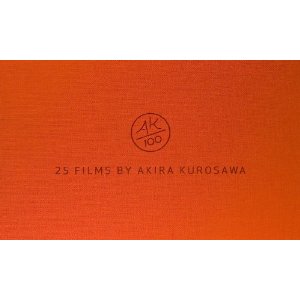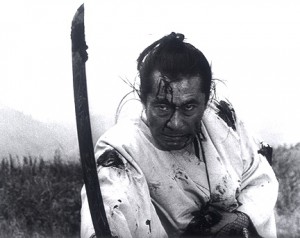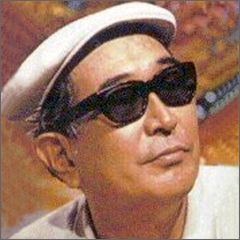AK 100: 25 Films of Akira Kurosawa
If you’re a fan of Asian cinema, then you absolutely must buy AK 100: 25 Films of Akira Kurosawa. The legendary director, who created such classics as Seven Samurai, Yojimbo and Rashomon, was born in 1910, and this collection was released in 2009 in anticipation of his 100th anniversary. While Kurosawa didn’t live to see it (he died in 1998), collectors will be absolutely thrilled by the quality of this Criterion Collection product. Twenty-five discs capture the Japanese director at his finest, and four of the films have never before been released on DVD. This is the most complete set of Akira Kurosawa films ever made available to the public, and devoted fans will get over 3,072 minutes of widescreen viewing pleasure. From postwar noir to samurai epics (Toshiro Mifune is the man!), he was truly a director without equal.

You can order AK 100: 25 Films of Akira Kurosawa from Amazon, and you’ll receive more than just the 25 DVDs (as if that weren’t enough). The whole thing comes packaged within a deluxe linen-bound collector’s set, and an illustrated book rounds out the collection. Filled with essays from Stephen Prince and Donald Richie, the tome is an excellent companion piece for learning more about each film before you view it.
And here’s a little something else to whet your appetite, courtesy of the Criterion Collection:
A lot of the director’s more obscure works are included in AK 100: 25 Films of Akira Kurosawa, and many of these haven’t been released by Criterion since the days of VHS. Whether you’re looking to experience his filmmaking magic for the first time, or you want to update your collection with high-quality DVD transfers, you simply can’t go wrong.
Order AK 100: 25 Films of Akira Kurosaw at Amazon Now
AMAZON CUSTOMER REVIEWS
I mentioned earlier that Amazon sells the Akira Kurosawa collection, so let’s pause for a moment and take a look at some of the overwhelmingly positive comments left by customers.
- “I’m fortunate to be just starting my Akira Kurosawa collection. With this collection, I get 25 of his 30 movies in one set. I love the Criterion collection and have many titles from them. Great picture quality, sound and lots of extras.”
- “Every single film is presented in the usual excellent picture quality and audio presentation! If you have purchased Criterion products in the past, you already know that they deliver the very BEST technical film presentation than anyone else in the industry.”
- “For those of us whose Kurosawa collection was on VHS, this was a terrific bargain. Quality of sound and video surprisingly good.”
- “Wonderful boxed set. Lovely quality collectable set.”
Order AK 100: 25 Films of Akira Kurosaw at Amazon Now
AKIRA KUROSAWA FILM COLLECTION
Since he directed exactly 30 films during his 57 year career, that means this Akira Kurosawa collection is missing only five titles. Those can be picked up separately, and Amazon is once again the place to go. Here’s a complete list of the films included in AK 100: 25 Films of Akira Kurosawa, along with a description of each.
Sanshiro Sugata (1943) – Kurosawa makes his directorial debut in this action-packed tale of the fierce competition between judo and jujitsu practitioners.
The Most Beautiful (1944) – Made during World War II about female factory workers who install lenses for targeting scopes and binoculars.
Sanshiro Sugata Part Two (1945) – Most of the original cast returns, and this time our judo-fighting hero gets to take on an American boxer. It was filmed near the end of World War II, so guess who wins?
The Men Who Tread on the Tiger’s Tail (1945) – A 12th-century lord and his samurai attempt to cross through enemy territory. Based on a kabuki play.
No Regrets for Our Youth (1946) – In 1933 Japan, a professor’s daughter is drawn to a radical student and later attempts to redeem him in the eyes of his parents.
One Wonderful Sunday (1947) – In post-war Tokyo, a young couple seek employment, lodging, and a little entertainment. Deals with themes of young love and the devastating effects of World War II on Japan.
Drunken Angel (1948) – A criminal with tuberculosis (Toshiro Mifune) strikes up an unusual friendship with a doctor. See this one for an example of Japanese film noir.
Stray Dog (1949) – A cop has his gun stolen by a pickpocket on a bus and must go undercover to retrieve it. Another Akira Kurosawa film that falls into the noir category.
Scandal (1950) – A painter meets a beautiful singer, but the press paints their relationship as a shameful affair. The painter’s lawyer is little help, as he plays both sides against one another.
Rashomon (1950) – Highly influential for its use of multiple accounts of the same event, Rashomon tells the story of a murdered samurai, his raped wife, and the man accused of the crimes.
The Idiot (1951) – An adaptation of Fyodor Dostoyevsky’s story of a pure man’s reintegration into a corrupt society.
Ikiru (1952) – A bureaucrat dying of stomach cancer seeks to find meaning in his life during his final days on Earth. Considered by many to be the greatest Akira Kurosawa film.
Seven Samurai (1954) – A group of wandering samurai are hired by farmers to protect their village from bandits. Remade dozens of times over the years in countries around the world.

I Live in Fear (1955) – An aging Japanese businessman moves his family to South America due to fear of a nuclear attack.
Throne of Blood (1957) – Toshiro Mifune stars in this retelling of Shakespeare’s Macbeth.
The Lower Depths (1957) – Adapted from the Maxim Gorky play about murder and passion in a dilapidated tenement building.
The Hidden Fortress (1958) – With two idiotic peasants along for the ride, a general and a princess attempt to pass through hostile territory with a royal treasure.
The Bad Sleep Well (1960) – A cross between film noir and Hamlet, this film tells of an executive hunting down his father’s killer.
Yojimbo (1961) – Mixing action and dark comedy, this films tells of a wandering samurai who attempts to save a village by turning two warring clans against one another.
Sanjuro (1962) – Toshiro Mifune reprises his role from Yojimbo. This time he’s helping a group of young samurai eliminate the corruption in their clan.
High and Low (1963) – Taking a look at Japanese society, High and Low stars Toshiro Mifune as an industrialist who must rescue his family from a kidnapper.
Red Beard (1965) – Exploring the theme of social injustice, this classic Akira Kurosawa film examines the relationship between an arrogant young doctor and his mentor, an aging country physician. Toshiro Mifune’s last role with the director.
Dodes’ka-den (1970) – One of the most heartbreaking Akira Kurosawa films, it follows the lives of the destitute living in the slums of Tokyo.
Kagemusha (1980) – When a warlord dies, a common criminal who bears a striking resemblance is taught to impersonate him in order to save the clan.
Madadayo (1993) – The final film from Akira Kurosawa, it’s meant as a tribute to Japanese academic and author, Hyakken Uchida. The relationship between Uchida and his students is explored as each passing birthday is celebrated. A fitting end to a masterful career.
Order AK 100: 25 Films of Akira Kurosaw at Amazon Now
AKIRA KUROSAWA – A BRIEF BIO
Considered one of the most important filmmakers to have ever lived, Akira Kurosawa born on March 23rd, 1910 in the suburbs of Tokyo. The youngest of eight children, Akira’s family was descended from a line of samurai, a subject that would help fuel his later career in cinema.
When he was 13, Akira and his older brother Heigo went on foot to tour the aftermath of the Great Kanto earthquake that had decimated Tokyo. Over 100,000 people had died in the disaster, and the brothers were confronted with corpses of people and animals at every turn. This proved a pivotal moment for the future director, as his brother urged him not to look away from the death and destruction. He obeyed, thus learning that facing something horrible head-on was the best way to rob it of its power. This willingness to confront unpleasant subjects would become a hallmark of his films, especially those dealing with madness, murder, and poverty.
By the time he was 23, Akira was the only one of his brothers still alive. Heigo had committed suicide, and his eldest male sibling passed away four months later. During the years leading up to these events, Akira read literature, wrote articles for a radical newspaper, and developed his painting technique.
His original career goal was to become a painter, but this was abandoned for a job in the Japanese film industry in 1936. Even though he never became a professional artist, Kurosawa would continue with his passion, and the storyboards for his films would often be rendered as paintings.

For years, he worked as a scriptwriter and assistant director, learning the ins and outs of the business (Kurosawa also edited his films). His directorial debut would come as World War II raged on (Sanshiro Sugata), and he would first team with star Toshiro Mifune following his country’s defeat (Drunken Angel). This would prove an important pairing, as the director and actor would work together a total of 16 times.
After the success of Rashomon, Kurosawa’s films gained an audience in Europe and North America, and other Japanese filmmakers also gained well-deserved exposure, including Yasujiro Ozu and Kenji Mizoguchi. Highly prolific during the ‘50s and ‘60s, Kurosawa would release one film per year. Many of these are now considered classics, such as Yojimbo and Seven Samurai.
His work slowed down by the middle of the ‘60s, and he attempted suicide in 1971 by slashing his wrist with a razor thirty times. He survived, and while his output was never as great, he went on to make instant classics such as Ran (1985) and Kagemusha (1980). While always a huge hit with North American and European audiences, his fellow countrymen often viewed his work as too influenced by Western ideals. Not coincidentally, Kurosawa’s all-time favorite filmmaker was John Ford.
His final film was 1993’s Madadayo, and he received an Academy Award for Lifetime Achievement three years earlier. At the age of 88, the great director would pass away from a stroke in his home city of Tokyo.
Oddly enough, he had always wanted to direct a Godzilla film, but the executives at Toho Co., Ltd. assumed it would cost them too much. One can only imagine the majesty of Toshiro Mifune versus a giant, fire-breathing lizard.
Order AK 100: 25 Films of Akira Kurosaw at Amazon Now
DIRECTORIAL STYLE OF AKIRA KUROSAWA
When viewing the 25 films in the Akira Kurosawa, here are some directorial techniques and habits to keep an eye out for. Hopefully, this will add an even greater degree of enjoyment to your experience.
- Known as a perfectionist during filming, Kurosawa once demanded that a stream be made to flow in the opposite direction. He also had the roof of a house removed and then put back again.
- Usually avoided fully orchestrated music (especially in his early films). Preferred the sounds of a single instrument for a scene.
- After each day of filming concluded, Kurosawa would head to the editing room and cut the dailies himself.
- Often placed cameras far away from actors. He believed that this less intrusive method of filming would improve the performance of his actors.
- Well known for his use of rain to heighten the mood of a scene. When a young Kurosawa met his idol, John Ford, the veteran director remarked, “You really like rain.” Kurosawa replied, “You’ve really been paying attention to my films.”
- Transitions from one scene to the next were often accomplished with wipes. This would later be emulated by George Lucas–himself a fan of Kurosawa–in the Star Wars series.
- Frequently worked with actors Toshiro Mifune and Takashi Shimura. The director paired with Mifune in 16 films, with the actor usually in a leading role. Shimura appeared in 21 films, alternating between supporting and leading parts.
- Used multiple cameras during action scenes to capture events from multiple angles and prevent the actors from knowing which camera was shooting them (and thus instinctively turning towards it).
- Obsessed with realism in his film, he once had professional archers fire real arrows only centimeters from Toshiro Mifune’s body in Throne of Blood. He also had truckloads of water dyed with calligraphy ink to better show up against the sky. Kurosawa insisted that costumes looked worn, often giving them to actors weeks in advance and asking them to break the garments in before filming.
- Sometimes referred to as “Emperor” by the Japanese press for his perceived dictatorial directing style. According to his cast and crew, however, this reputation was greatly exaggerated.
- With his background as a painter, many of Kurosawa’s shots were framed as though they were singular works of art.
- Used telephoto lenses to flatten out the frame.
- His samurai films were not considered traditional in Japan due to his habit of setting them in the feudal periods of the 16th and 17th centuries. More traditional samurai films were usually set in the 18th and 19th centuries.
INFLUENCES ON AKIRA KUROSAWA
The following are a list of the many influences on Akira Kurosawa. If you’re a fan of his work, it’s worth your time to explore the artists who inspired him to greatness.
- William Shakespeare (Ran, Throne of Blood, and The Bad Sleep Well are all based on his works.)
- Fyodor Dostoyevsky (His favorite author, Kurosawa adapted The Idiot in 1951.)
- Maxim Gorky (Russian playwright whose The Lower Depths was adapted by Kurosawa in 1957.)
- Leo Tolstoy (Russian author whose The Death of Ivan Ilyich inspired Kurosawa‘s Ikiru.)
- Vladimir Arsenyev (Russian explorer. Kurosawa’s Dersu Uzala was based on his memoirs.)
- Ed McBain (American crime writer whose King’s Ransom was the basis for Kurosawa’s High and Low.)
- Dashiell Hammett (American author whose Red Harvest served as inspiration for Yojimbo.)
- Georges Simenon (Belgian writer. Stray Dog was Kurosawa’s attempt to create a story in his style.)
- Frank Capra (American filmmaker)
- Howard Hawks (American filmmaker)
- William Wyler (American filmmaker)
- Kajiro Yamamoto (Japanese filmmaker and Kurosawa’s mentor)
- John Ford (American filmmaker and Kurosawa’s favorite director)
THOSE INFLUENCED BY AKIRA KUROSAWA
Since he’s one of the greatest filmmakers to ever stand behind a camera, it’s a given that many directors and feature films have been influenced by the works of Akira Kurosawa. Here’s a list of some of the many artists who’ve been inspired by or downright copied the master. Remakes of Kurosawa films are also listed.
- Ingmar Bergman
- Martin Scorsese
- Federico Fellini
- The Magnificent Seven (1960) (Seven Samurai)
- Bernardo Bertolucci
- A Fistful of Dollars (1964) (Yojimbo)
- Steven Spielberg
- Tsubaki Sankuru (2007) (Sanjuro)
- Robert Altman
- Andrei Tarkovsky
- George Lucas
- The Last Princess (2008) (The Hidden Fortress)
- John Woo
- The Outrage (1964) (Rashomon)
- Sergio Leone
- Zhang Yimou
- Antoine Fuqua
- Takeshi Kitano
- Last Man Standing (1996) (Yojimbo)
- Sidney Lumet
- Werner Herzog
- Star Wars (1977) (heavily influenced by The Hidden Fortress)
- Sam Peckinpah
- Arthur Penn
- John Milius
- Francis Ford Coppola
- Roman Polanski
- Alex Cox
Now that you know a little more about the man and his films, why not rush over to Amazon and buy the Akira Kurosawa collection? We do get a small commission if you make a purchase, but all proceeds go towards making sure that we can continue to bring you quality posts like this one.
Order AK 100: 25 Films of Akira Kurosaw at Amazon Now
This entry was posted on Wednesday, June 23rd, 2010 at 7:16 pm and is filed under Good Movies, Interesting Movie Facts, New DVD Releases, Thoughts on Film. You can follow any responses to this entry through the RSS 2.0 feed. You can leave a response, or trackback from your own site.
Trackbacks/Pingbacks
- PSP Movies - PSP Movie Format - Good PSP Films
- Famous Film Directors - Greatest Movie Directors
- The Twilight Zone DVD Collection - The Twilight Zone Box Set
- Masters of Horror Box Set - Masters of Horror Collection
- Friday the 13th Box Set - Friday the 13th Collection
- Lone Wolf and Cub Box Set - Lone Wolf and Cub Collection
- David Lynch Box Set - David Lynch Collection
- Quentin Tarantino Movies - Films by Quentin Tarantino
- George Lucas Movies, Films, Projects, 2012
